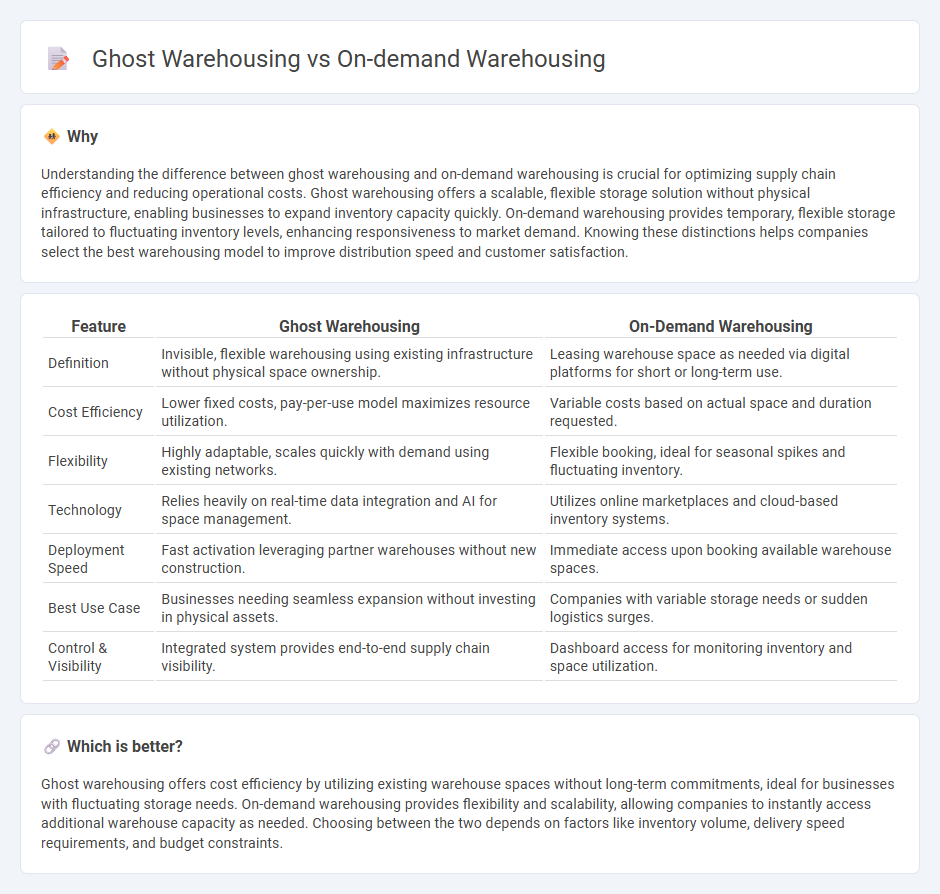
Ghost warehousing leverages unoccupied warehouse space to provide flexible, cost-efficient storage solutions without long-term commitments, contrasting with on-demand warehousing that offers scalable, pay-as-you-go access to inventory management. This approach enhances supply chain agility by optimizing space utilization and reducing overhead costs. Discover how these innovative warehousing models can revolutionize your logistics strategy.
Why it is important
Understanding the difference between ghost warehousing and on-demand warehousing is crucial for optimizing supply chain efficiency and reducing operational costs. Ghost warehousing offers a scalable, flexible storage solution without physical infrastructure, enabling businesses to expand inventory capacity quickly. On-demand warehousing provides temporary, flexible storage tailored to fluctuating inventory levels, enhancing responsiveness to market demand. Knowing these distinctions helps companies select the best warehousing model to improve distribution speed and customer satisfaction.
Comparison Table
| Feature | Ghost Warehousing | On-Demand Warehousing |
|---|---|---|
| Definition | Invisible, flexible warehousing using existing infrastructure without physical space ownership. | Leasing warehouse space as needed via digital platforms for short or long-term use. |
| Cost Efficiency | Lower fixed costs, pay-per-use model maximizes resource utilization. | Variable costs based on actual space and duration requested. |
| Flexibility | Highly adaptable, scales quickly with demand using existing networks. | Flexible booking, ideal for seasonal spikes and fluctuating inventory. |
| Technology | Relies heavily on real-time data integration and AI for space management. | Utilizes online marketplaces and cloud-based inventory systems. |
| Deployment Speed | Fast activation leveraging partner warehouses without new construction. | Immediate access upon booking available warehouse spaces. |
| Best Use Case | Businesses needing seamless expansion without investing in physical assets. | Companies with variable storage needs or sudden logistics surges. |
| Control & Visibility | Integrated system provides end-to-end supply chain visibility. | Dashboard access for monitoring inventory and space utilization. |
Which is better?
Ghost warehousing offers cost efficiency by utilizing existing warehouse spaces without long-term commitments, ideal for businesses with fluctuating storage needs. On-demand warehousing provides flexibility and scalability, allowing companies to instantly access additional warehouse capacity as needed. Choosing between the two depends on factors like inventory volume, delivery speed requirements, and budget constraints.
Connection
Ghost warehousing and on-demand warehousing are connected through their shared use of flexible, technology-driven inventory management solutions that optimize space and reduce overhead costs. Both models leverage real-time data analytics and cloud-based platforms to match supply and demand efficiently, enhancing scalability for e-commerce and retail businesses. This integration allows businesses to dynamically allocate warehousing resources without long-term commitments, improving operational agility.
Key Terms
**On-demand warehousing:**
On-demand warehousing offers flexible storage solutions by connecting businesses with available warehouse space through an online platform, allowing for scalable inventory management without long-term leases. This model enables real-time tracking, cost efficiency, and adaptability to seasonal demand fluctuations, providing a competitive edge in supply chain operations. Explore more about how on-demand warehousing can optimize your logistics strategy and reduce overhead costs.
Flexible storage
On-demand warehousing offers flexible storage solutions by allowing businesses to rent space only when needed, providing scalability without long-term commitments. Ghost warehousing involves third-party spaces invisibly integrated into supply chains, optimizing storage without physical presence or branding concerns. Explore how these models enhance inventory management and operational agility for dynamic businesses.
Real-time inventory
On-demand warehousing offers dynamic allocation of storage space with real-time inventory tracking, enabling businesses to respond swiftly to fluctuating demand. Ghost warehousing operates through third-party logistics providers using shared warehouse networks, often lacking immediate inventory visibility but benefiting from scalability and cost-efficiency. Explore the differences in real-time inventory management to optimize your supply chain strategy effectively.
Source and External Links
On-Demand Warehouse: Definition, Examples, and Uses - On-demand warehousing is a flexible and cost-effective storage solution allowing businesses to rent space only as needed, supporting seasonal scaling and faster fulfillment without long-term contracts.
On-Demand Warehousing 101 - Flexe - This model relies on a marketplace and transactional pricing to connect businesses needing flexible warehousing with providers, enabling pay-as-you-go rentals for scalable, flexible storage and fulfillment.
How on demand warehousing benefits your business | Ware2Go - On-demand warehousing is a fulfillment model where a 4PL provider negotiates space and labor with warehouses on behalf of merchants, enabling scalable, cost-efficient fulfillment networks for faster shipping and competitive advantage.
 dowidth.com
dowidth.com